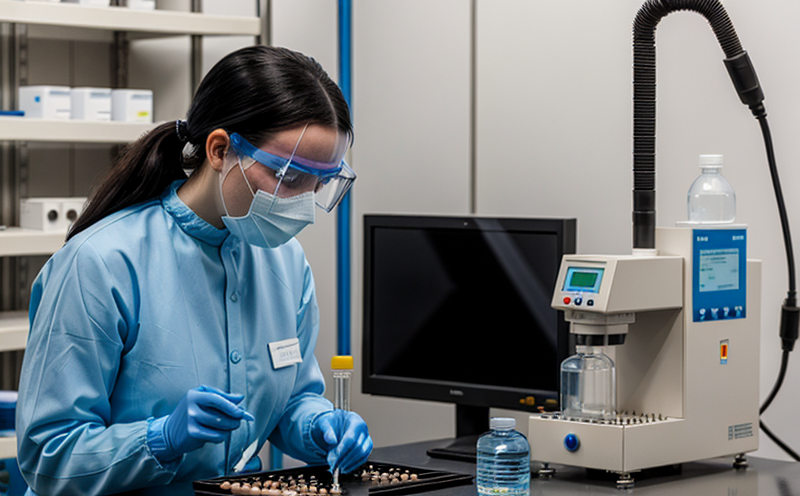USP 231 Heavy Metals Testing
The United States Pharmacopeia (USP) Test Chapter 231: Determination of Arsenic, Mercury, Lead and Other Heavy Metals is a critical method used to ensure the quality and safety of pharmaceutical products. This test evaluates heavy metals present in medications, dietary supplements, and other dosage forms to meet stringent regulatory requirements.
The primary goal of USP 231 testing is to prevent contamination from toxic elements that could adversely affect human health. The test detects trace amounts of harmful substances such as arsenic (As), mercury (Hg), lead (Pb), cadmium (Cd), and others, which can accumulate in formulations over time if not properly controlled.
The methodology relies on the use of highly sensitive instruments like Inductively Coupled Plasma Mass Spectrometry (ICP-MS) or Flame Atomic Absorption Spectroscopy (FAAS). These tools provide precise measurements down to parts per billion levels, ensuring accurate quantification even when dealing with very low concentrations.
Preparation for testing typically involves dissolving the sample in appropriate solvents followed by digestion steps using acids. This process helps release heavy metals bound within the matrix of pharmaceutical products so they can be detected effectively during analysis.
The results from USP 231 tests are essential not only for compliance with regulatory bodies like the FDA but also because they protect consumers against potential health risks associated with excessive exposure to harmful elements. By adhering strictly to these standards, manufacturers ensure product integrity and build consumer trust.
| Sample Type | Acceptance Criteria | Methodology |
|---|---|---|
| Pills, tablets, capsules | Levels of heavy metals must not exceed specified limits as per USP guidelines. | Use of ICP-MS or FAAS to measure concentrations. |
| Dietary Supplements | Compliance with permissible thresholds set forth by regulatory authorities. | Involves sample preparation and instrumental analysis. |
| Vitamins & Minerals | Ensuring no harmful contaminants are present at unacceptable levels. | Follows standard procedures outlined in USP 231. |
In summary, the USP 231 Heavy Metals Test plays a pivotal role in safeguarding public health by ensuring that pharmaceutical products do not contain excessive amounts of toxic elements. It provides data necessary for meeting regulatory standards while enhancing overall product safety and efficacy.
Industry Applications
- Pills, tablets, capsules
- Dietary supplements
- Vitamins & Minerals
| Sample Type | Acceptance Criteria |
|---|---|
| Pills, tablets, capsules | Levels of heavy metals must not exceed specified limits as per USP guidelines. |
| Dietary supplements | Compliance with permissible thresholds set forth by regulatory authorities. |
| Vitamins & Minerals | Ensuring no harmful contaminants are present at unacceptable levels. |
The USP 231 Heavy Metals Test finds application across various sectors including pharmaceuticals, dietary supplements, and vitamins/minerals. It is particularly important for ensuring compliance with regulatory standards such as those stipulated by the FDA (United States Food and Drug Administration).
Compliance with these stringent regulations helps protect consumers from potential health risks associated with excessive exposure to harmful elements found in certain medications or supplements.
Why Choose This Test
The USP 231 Heavy Metals Testing method offers several advantages that make it an indispensable tool for ensuring the safety and quality of pharmaceutical products. Firstly, its ability to detect trace amounts of heavy metals provides manufacturers with valuable insights into potential contamination issues early in the production process.
Secondly, adherence to this test ensures compliance with international standards set by organizations like USP, which are recognized worldwide as benchmarks for excellence in drug manufacturing practices. This enhances credibility and trust among consumers who rely on these products for their health needs.
Thirdly, regular testing allows companies to maintain consistent quality across batches of medication or supplements, thereby improving customer satisfaction levels significantly. Finally, the availability of detailed reports generated by this test enables better decision-making regarding process improvements aimed at minimizing contamination risks further down the line.
Environmental and Sustainability Contributions
The USP 231 Heavy Metals Testing contributes positively to both environmental sustainability efforts and corporate social responsibility initiatives. By ensuring that pharmaceutical products contain minimal amounts of toxic elements, this testing method helps reduce pollution risks associated with improper disposal practices.
Moreover, by promoting strict adherence to regulatory standards, it encourages responsible sourcing and manufacturing processes which are crucial for maintaining ecological balance. This, in turn, supports broader sustainability goals such as reducing waste generation and conserving natural resources.
In addition, the transparency provided through comprehensive reporting allows stakeholders—from regulators to end-users—to stay informed about product safety and quality, fostering a culture of trust and accountability within the industry.





